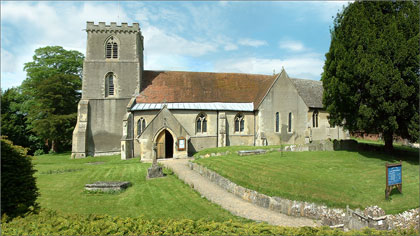History of St Matthew's Harwell

St. Matthew's Church Harwell stands on a small eminence adjacent to Princes Manor farm to the East, and is bounded by a stream which rises in the nearby area of Wellshead to the West. The Church was mainly built in the 13th Century and has rubble walls of clunch covered with plaster on the inside and with roughcast on the outside. Its size reflects the existence of a considerable population in the village, then on the Wallingford to Gloucester highway, and was formerly dedicated to St. Mary. The date of the rededication to St. Matthew's is not known.
11th to 13th Centuries
In the 11th and 12th centuries there was a chancel and aisleless nave: of the latter, some clunch foundations which include stone set in the herringbone style were found in 1963 when the floors in the nave, aisles and transepts were renewed. In the Doomsday Survey a chapel is mentioned and in 1074 a dwelling and certain tithes (those normally reserved for the upkeep of the church and the care of the poor) were granted to the Chapel of St. George in the newly built castle at Oxford. These and similar tithes elsewhere were transferred in 1149 to Osney Abbey.
Augustinian Monastery influenced the design and architectural details of much of the present church. The church has always been connected with the Upper Manor which was granted by William the Conqueror to Rollers d'Oyley who in turn gave it, with others in Oxfordshire, to his comrade Roger d'Iveri the Barony (or Honour) so formed had its capital seat at Beckley, Oxon.
After the d'Iveri line had become extinct the Honour was granted, in about 1157 to the family of St. Valery. During the 13th century various freeholders held the Manor, the most notable of these being Sir Jocelyn Balliol and his decedents who held half a Knights fee. There was an important influence after 1231 when the honour with that of Wallingford was bestowed on the King's brother, Richard Earl of Cornwall, and after Richards's death in 1272, on his son Edmund.
13th to 20th Centuries
Rectors appointed by Edmund were his treasurer, Roger de Drayton (1276 1292) and a keeper of his wardrobe, Roger de Marlowe (1292 1310) known for his letters and letter book: Walter de London (1310 1349) was non-resident being a King clerk and holding several other benefices including eventually the Deanery of Wells.
Between 1359 and 1361, the Black Prince increased the endowments of the College of St. Nicholas in his castle at Wallingford by successive grants of the advowson, the church (that in the Rectorial tithes) and the Upper Manor. They reverted to the Crown when the College was suppressed in 1548 and the Loder family, the tenants of the Manor Farm, were thus able to purchase the Manor and the advowson in 1557. These passed to the Raymonds in the 18th century and to the Chetwodes in the 19th century.
In the present century (since 1916) the patron has been the Church Pastoral Aid Society and in 1976 Harwell became a united benefice with Chilton under the joint patronage of the Oxford Diocesan Board of Patronage and C.P.A.S.
Click to history of the building
Click to 360 degree virtual tour of the building as it was in 2013
Click here for photos of Old Harwell (external site)
Click here for further archive material (external site)
Click here for Friends of St Matthew's Harwell brochure